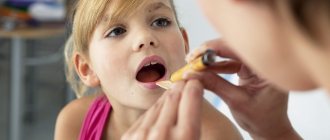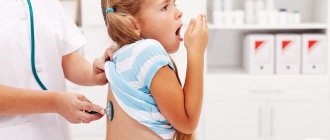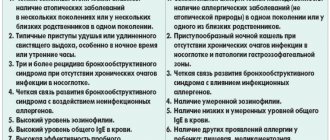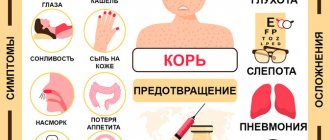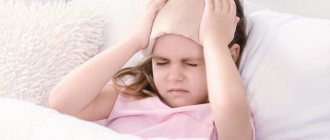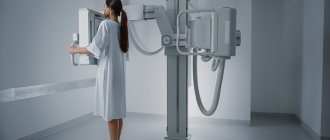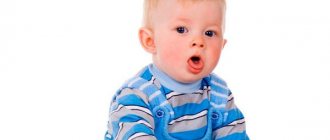Causes of whooping cough
Whooping cough is transmitted by airborne droplets. The incubation period ranges from 3 to 14 days (usually 5-7 days). The causative agent of whooping cough quickly dies in the external environment. Therefore, for example, for the room where the patient was, no special treatment is required - it is enough to ventilate it properly, and simply wash the dishes and toys with soap.
However, whooping cough is a highly contagious disease. When in contact with a sick person (a distance of 2 meters is considered critical), the probability of becoming infected is very high (more than 70%). The smallest particles of mucus that carry the infection fly out when the child coughs, talks, or cries and enters the respiratory system with the air.
The prevalence of whooping cough is also facilitated by the fact that the disease often occurs in a blurred form. In a similar way, whooping cough occurs in adults or against the background of vaccination. An infection that causes a habitual and harmless cough in an adult, if transmitted to a child who does not have immunity to whooping cough, can cause a typical form of the disease in him. Even a newborn can get sick, since antibodies to the causative agent of whooping cough are not transmitted from mother to child.
The patient is contagious from the 1st to the 25th day of illness. However, with timely treatment, the duration of the infectious period can be reduced.
Diagnosis of parapertussis in children
Parapertussis can have clinical recommendations in children only after diagnosis. In this aspect, competent diagnosis occupies a paramount position. Parapertussis cannot be diagnosed based solely on the clinical picture and history of complaints. This can be a medical error. A clue may be the presence of contact with a previously infected child. In this case, the likelihood of infection is high. Tests for whooping cough and parapertussis in children are a serological method and the main diagnostic procedure. The results allow us to examine the presence of antibodies in the blood. They represent the body's immune defense and a tool for fighting bacteria. The bacteriological diagnostic method consists of detecting gram-negative bacilli in the mucus. Tests for parawhooping cough in children in this case are taken from the back of the throat (smear). To complete the picture, a urine test is done.
Whooping cough symptoms
The onset of the disease resembles a common acute respiratory infection: the temperature rises slightly, nasal discharge appears, and a rare dry cough. Subsequently, the cough intensifies, becoming spasmodic in nature.
Runny nose
Whooping cough usually begins with the appearance of mucous discharge from the nose. They may appear even before the temperature rises. The child begins to sneeze and cough.
More about the symptom
Temperature
At the onset of the disease, as a rule, there is a slight increase in temperature - up to 37-37.5 ° C.
More about the symptom
Cough
At the first stage of the disease, the cough is dry and rare. Traditional methods of treating cough for whooping cough for ARVI do not help, the cough gradually intensifies. After 10-14 days from the onset of the disease, spasmodic coughing attacks typical of whooping cough are observed.
Such an attack looks like a series of coughing shocks, followed by a deep wheezing breath. Then - new coughing tremors. This cycle can be repeated several times (from 2 to 15 - depending on the severity of the disease). The cough is not easy; The child’s face may turn blue and the neck veins may swell. He sticks out his tongue; this may cause injury to the frenulum of the tongue. Infants may stop breathing. The attack ends with the release of a small amount of glassy sputum or vomiting. The number of such attacks can reach up to 50 per day.
The period of spasmodic cough lasts 3-4 weeks. After this, the cough (already normal, not spasmodic) persists for another 2-3 weeks.
More about the symptom
Prevention of parapertussis in children
Whooping cough and parawhooping cough in children exhibit the same symptoms, but with varying degrees of intoxication. This is influenced by the pathogenicity of the pathogen. To avoid encountering these diseases in an aggressive form, it is recommended to be vaccinated in accordance with the approved vaccination schedule. It is worth understanding that the DTP vaccine does not guarantee the absence of risks of getting sick. Its goal is immunization. It reduces the risk of complications and severe disease, including death.
To limit the spread of infection, a sick child must be isolated for 25 days. You can be admitted to groups only after receiving two negative results of a bacteriological analysis. General epidemiological recommendations should be followed. Children under 7 years of age who have had contact with bacteria carriers must be excluded from the group for at least 14 days. This is an incubation period during which it is difficult to determine the presence of a bacterial infection in the absence of symptoms. Parapertussis in children begins to receive treatment after the appearance of a dry cough in the anamnesis. Standard preventive measures include avoiding places with large crowds of people. It is recommended to harden children, follow a daily routine, and eat a balanced diet so that the body maintains strength and immunity to fight various bacteria.
Treatment methods for whooping cough
The causative agent of whooping cough is sensitive to antibiotics only at the beginning of the disease (before the period of spasmodic cough). If the disease has already entered this phase, treatment is aimed mainly at reducing the frequency and severity of attacks. To do this, if possible, eliminate the influence of irritating agents that cause coughing. The child needs to spend more time in the fresh air and be in a ventilated area. It is also important to relieve the allergic reaction caused by toxins produced by the causative bacteria.
The younger the sick child, the more severe the disease. Even death is possible. Therefore, it is very important to protect your child by vaccinating him against whooping cough. Even if the vaccinated child subsequently gets sick (there is such a possibility), his disease will proceed in a smoothed form, without painful spasmodic attacks.
Drug treatment
Antibiotics kill the causative agent of whooping cough. However, as a rule, this occurs relatively late, since whooping cough is often not recognized at the onset of the disease. By the time antibiotics are used, the pathogen usually already affects the cough receptors in the brain. Therefore, the cough continues even after the destruction of the whooping cough bacillus.
Expectorants, antihistamines, sedatives and other drugs can also be used in the treatment of whooping cough. Their action is aimed at preventing possible complications, but they cannot speed up relief from cough.
Vaccination
Vaccination against whooping cough is included in the National and Regional calendars of preventive vaccinations; immunization of children begins at 3 months of age and consists of several sequential vaccinations. By contacting Family Doctor JSC about immunization against whooping cough, you guarantee that the vaccine will be of adequate quality, and the actions of medical personnel will be professional and qualified.
You should consult a pediatrician about vaccinating your child against whooping cough.
More information about the treatment method
Make an appointment Do not self-medicate. Contact our specialists who will correctly diagnose and prescribe treatment.
Rate how useful the material was
thank you for rating
Possible complications after vaccination
Unpleasant consequences after vaccination against whooping cough rarely occur; according to statistics, in Moscow, out of 1 million vaccinations, there were only 8 cases that were accompanied by any complications. They are mainly local in nature and can appear in the first two days after vaccination. A person may feel a general malaise, observe an increase in body temperature, swelling, soreness or hyperemia at the injection site. In extremely rare cases, seizures or various allergic reactions may occur.
Vaccination may not be carried out if a person has diseases of the nervous system, a history of afebrile seizures, atypical reactions to a previous vaccination and hypersensitivity to components in the vaccine. The decision to cancel or postpone vaccination is made by the doctor.
Parents can protect their children from the 17 most dangerous infectious diseases. Here is their list:
- Tuberculosis
- Viral hepatitis B
- Rotavirus infection
- Pneumococcal infection
- Diphtheria
- Tetanus
- Polio
- Haemophilus influenzae infection
- Measles
- Rubella
- Parotitis
- Meningococcal infection
- Viral hepatitis A
- Chicken pox
- Flu
- Human papillomavirus
- Calendar of children's preventive vaccinations
How contagious is the infection?
Whooping cough is most contagious at the very beginning, when the diagnosis is not yet entirely clear and even doctors may believe that it is an acute respiratory infection, so many mothers begin to panic when they find out that their children have been in contact with sick people. However, there is no need to panic.
- Firstly, children from one to seven years of age are most susceptible to infection. Older people are less at risk of contracting the infection.
- Secondly, with a strong immune system, the disease may not develop.
- Thirdly, it is direct contact that is dangerous; if children were simply in the same room but did not interact, then infection is unlikely.
If parents are very worried, then they can do an antibody test and prevent the development of the disease at a very early stage.
How many days does isolation last?
The duration of isolation depends on the incubation period of the pathogen.
If a focus of infection occurs, it is recommended to exclude the sick person and everyone who was in close contact with him for a period of 14-16 days.
If the patient continues to attend a children's group, then it is recommended to isolate the group of children for up to 25 days, that is, exclude them from participating in general activities.
Time is counted from the last visit to the team by the last sick child, that is, with the emergence of a new case, the quarantine is extended .
Activities during this period
Since the pathogens quickly die outside the human body, there is no need to close the school or kindergarten where the outbreak of the disease was discovered. There is also no need for special treatments or disinfection.
- It is enough to ventilate the room more often, carry out wet cleaning, and quartz the room.
- If a whooping cough quarantine is declared in schools, a transition to distance learning is possible during this time.
- Mass events are also being cancelled, and medical examinations are being carried out.
- Children study in the same classrooms, without moving from class to class, and new students are not accepted.
Vaccination cannot be carried out during a whooping cough epidemic. As an emergency measure for unvaccinated children, they are given human immunoglobulin.
Can a healthy child go to kindergarten/school?
If your child was in kindergarten or school on the day when quarantine was announced, then he can continue to attend the children's group at the discretion of the parents.
However, if for some reason the child was not present that day, the administration of the child care institution may refuse to accept the child or transfer him to another group.
In addition, certain restrictions are imposed on the group or class in which quarantine for whooping cough is declared:
- in kindergartens, quarantined groups cannot walk in the areas of other groups or together with other groups;
- quarantined kindergarten classes or groups cannot participate in public events;
- in such groups it is not possible to conduct excursions or classes outside the group or class.
